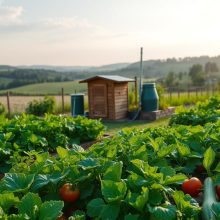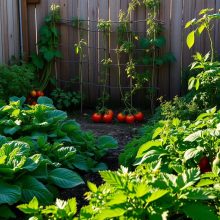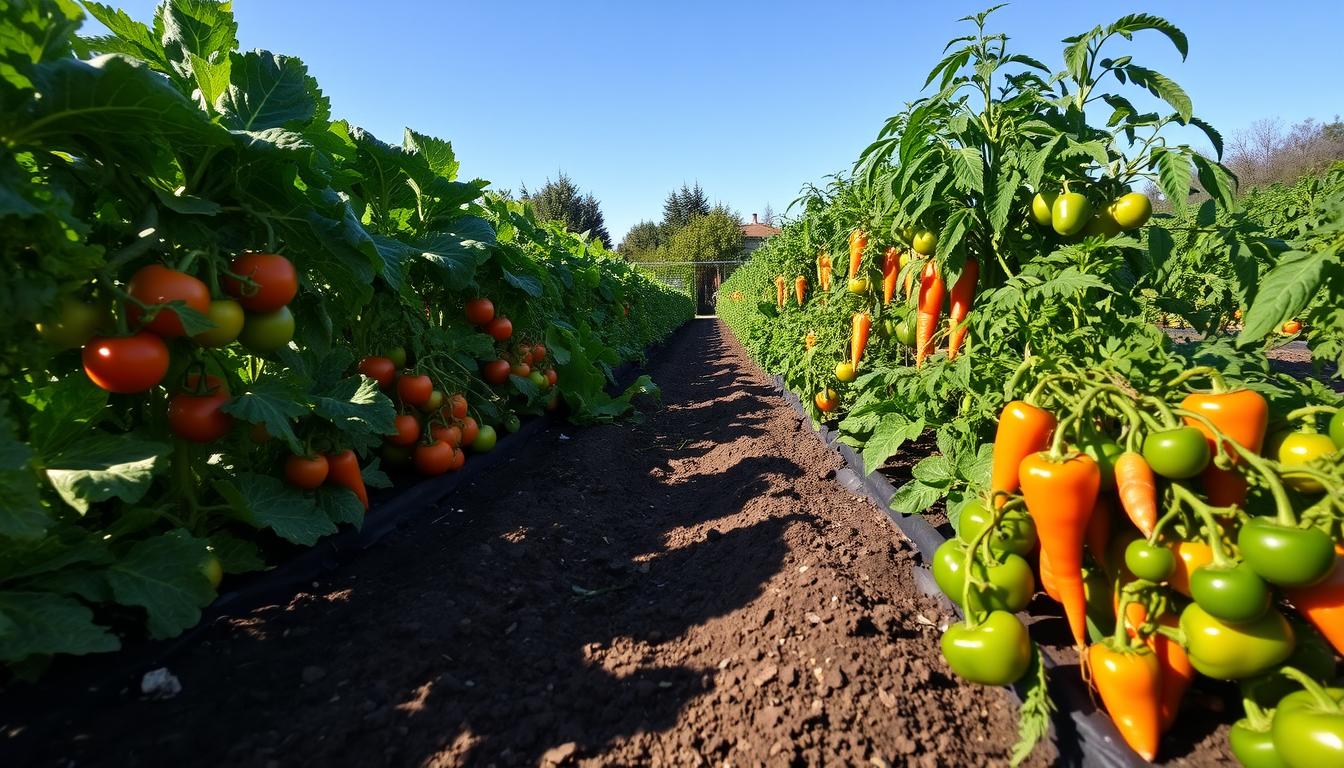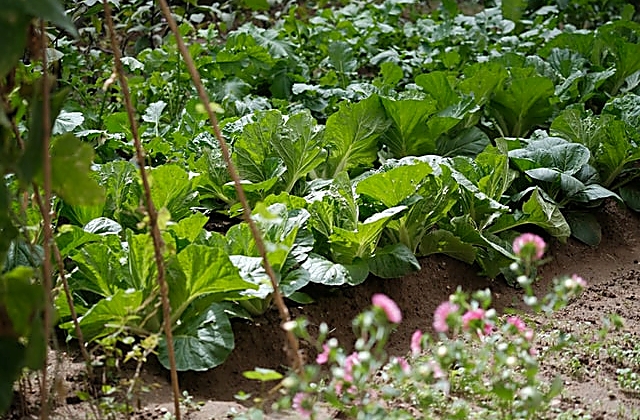Vegetable Gardening: Tips for Growing a Bountiful Harvest
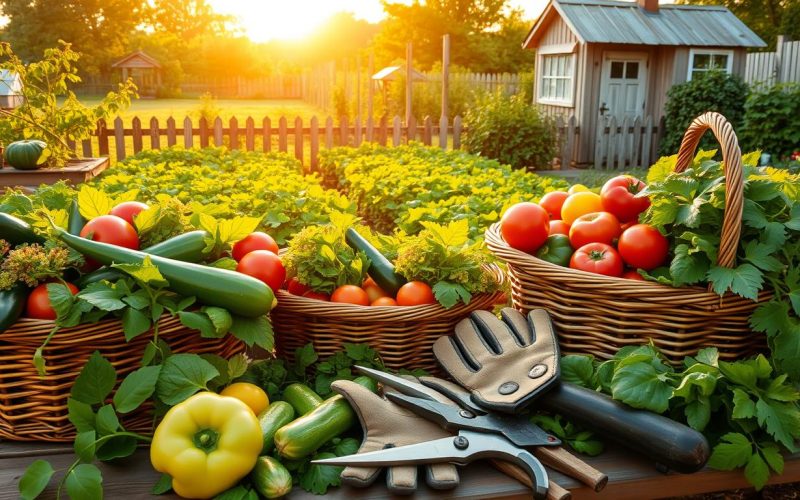
Growing your own vegetables is a journey filled with joy and discovery. It’s amazing to see a small area turn into a place full of fresh, healthy food. With the right steps and hard work, your garden can give you more than you could buy in stores.
Imagine picking tomatoes that grow so much, one seed can give you over 15 pounds. This shows how rewarding gardening can be for your health and taste. Even beginners can become experts with the right knowledge.
Whether you have a big backyard or a small balcony, you can garden. Knowing how to prepare the soil, choose plants, and care for them is key. This will help you grow a garden that gives you fresh food right at home.
Key Takeaways
- Vegetable gardening can produce substantial harvests from minimal space
- Single seeds can yield significant quantities of fresh produce
- Gardening provides nutritional and personal satisfaction
- Basic skills can transform anyone into a successful gardener
- Home vegetable gardens offer fresh, healthy food options
Understanding the Basics of Vegetable Gardening
Starting with vegetable gardening needs a good base of knowledge and prep. Knowing your local area and what your plants need is key. Every gardener starts by learning the basics to grow a successful garden.
Choosing the Right Vegetables for Your Climate
Picking the right veggies for your area is vital for a good harvest. Each region has its own climate challenges. Think about these when picking veggies:
- Find out your USDA hardiness zone
- Know your local weather and rain patterns
- Look up veggies that grow well in your area
- Think about when to plant for the season
Understanding Soil Composition and Health
Healthy soil is the start of organic gardening. Good soil helps veggies grow strong. Test your soil to see its pH and nutrient levels. Most veggies like soil that’s a bit acidic, with a pH of 6.0 to 7.0.
Importance of Crop Rotation
Crop rotation is key in veggie gardening. It keeps soil healthy and fights pests. By moving where you plant each season, you:
- Keep soil nutrients from getting used up
- Lower pest and disease risks
- Boost your garden’s health
- Get more veggies
Learning these basics will help you grow a garden that’s productive and good for the planet. It will give you fresh, healthy veggies all season.
Planning Your Vegetable Garden Layout
Creating a good vegetable garden layout needs careful planning and smart design. Successful gardeners know that good planning can turn small spaces into great growing areas. The right ideas can help you grow more and enjoy gardening more.
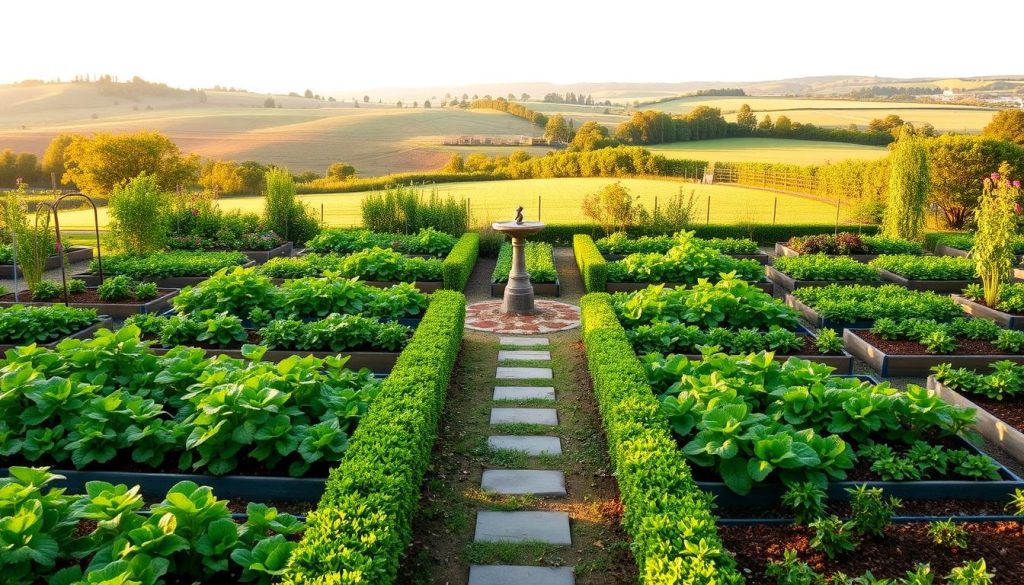
Square foot gardening is a great idea for home gardeners. It breaks down garden spaces into small sections. This lets you place plants just right and use space well. Using smart layout techniques can really increase your harvest.
Designing Garden Beds for Optimal Growth
When planning your garden, keep these design tips in mind:
- Create raised beds for better soil control
- Ensure adequate sunlight exposure
- Plan for easy access and maintenance
- Consider irrigation and drainage needs
Companion Planting: Friends in the Garden
Companion planting is a smart idea that helps plants grow better together. Some great plant pairs include:
- Tomatoes with basil – improves flavor and repels pests
- Carrots near onions – reduces pest interference
- Beans with corn – provides natural support and nitrogen
By using these planting strategies, gardeners can make a thriving garden. This garden will help plants grow well and fight off pests naturally.
Essential Tools for Successful Gardening
Starting a vegetable garden? You need the right tools. Good gardening tools make planting, caring for, and picking your crops easier. Whether you’re new or have been gardening for years, the right tools can make a big difference.
Must-Have Gardening Tools for Beginners
Every new gardener needs a few basic tools. Here are the key ones for your vegetable garden:
- Hand trowel for precise digging and planting
- Pruning shears for trimming and maintaining plants
- Garden gloves to protect your hands
- Watering can or garden hose with adjustable nozzle
- Sturdy garden fork for turning soil
- Wheelbarrow for moving soil, compost, and plants
Eco-Friendly Gardening Supplies
Organic gardening is more than just tools. It’s about using green practices too. Choose supplies that are good for the planet:
- Biodegradable seed starter pots
- Compost bins for natural fertilization
- Rain barrels for water conservation
- Organic fertilizers and pest control solutions
- Bamboo or recycled plastic garden tools
Choosing the right tools and green supplies helps your garden grow well. Remember, quality is more important than how many tools you have.
Soil Preparation Techniques
Getting your soil right is key to a great vegetable garden. Organic gardening starts with knowing and caring for your soil. Healthy soil leads to healthier plants and bigger harvests.
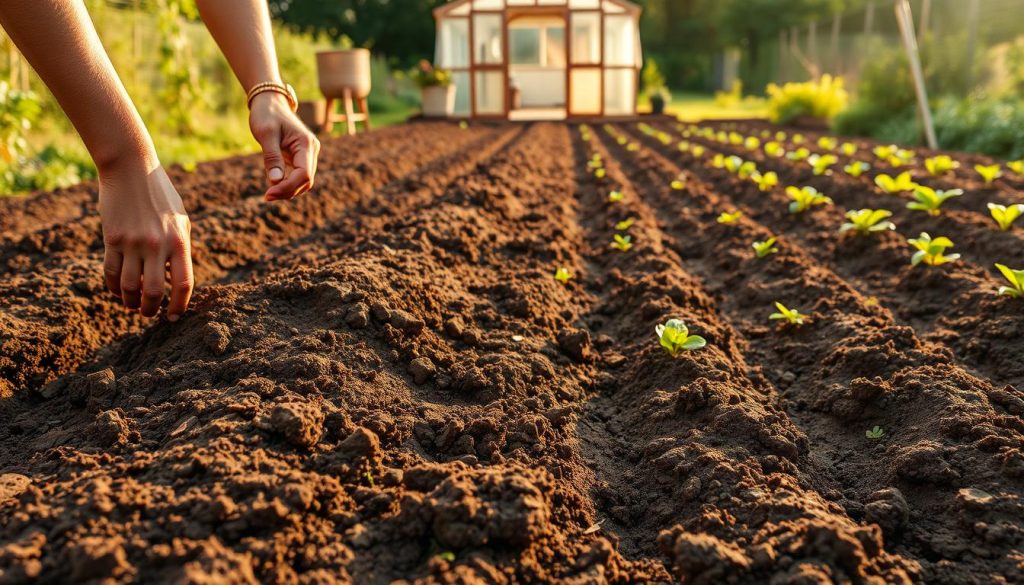
Testing Your Soil’s Nutrient Content
Understanding your soil is vital for a successful garden. Home gardeners can test their soil easily:
- Purchase a home soil testing kit from local garden centers
- Send soil samples to agricultural extension offices
- Look for key nutrient levels: nitrogen, phosphorus, and potassium
- Check soil pH to determine optimal growing conditions
Amending Soil for Maximum Yield
Organic gardening uses natural ways to improve soil. Compost is a top choice, adding nutrients and bettering soil structure. Here are some tips for improving your soil:
- Add aged compost to increase organic matter
- Use natural materials like aged manure or leaf mold
- Incorporate cover crops to replenish soil nutrients
- Apply organic fertilizers sparingly
With the right soil prep, your garden will flourish. It will become a place of nutritious food.
Planting Your Garden: Timing and Techniques
Starting a vegetable garden is all about timing and technique. It’s important to plan carefully to get a good harvest. Knowing when and how to plant is key to a successful garden.
Planting vegetables requires attention to detail. Each type of vegetable has its own needs. Let’s look at the basics of timing and planting.
When to Plant Different Vegetables
Timing is crucial in gardening. Each vegetable has the best time to plant, based on your area and weather. Here are some tips:
- Cool-season crops like peas and spinach do well in early spring
- Warm-season veggies like tomatoes and peppers need warmer soil
- Check your area’s frost dates
- Ask local nurseries or extension offices for exact planting times
Proper Planting Depth and Spacing
Planting at the right depth and spacing is vital. Each plant needs the right conditions to grow well.
- Read seed packet instructions carefully
- Make sure plants have enough space to grow
- Think about how big the plants will get when spacing them
- Use raised beds or rows for better plant arrangement
Understanding your garden is key to growing vegetables. Try new things, watch your garden, and learn from each season. This will help you get better at gardening.
Watering and Irrigation Strategies
Water is key for a thriving home vegetable garden. The right watering can make all the difference. It helps plants grow strong and healthy.
Good water management is more than just watering. It’s about giving plants the right amount of moisture. This keeps them healthy and boosts your harvest.
Best Practices for Watering Your Garden
- Water deeply and less often to help roots grow strong
- Water at the base of plants to avoid wet leaves
- Water in the morning to cut down on evaporation
- Use mulch to keep soil moist and save water
Understanding Drip Irrigation Systems
Drip irrigation is a big step up for gardeners. It waters plants right at the roots. This cuts down on waste and fights off diseases.
- Drip systems use less water than sprinklers
- Keep roots moist all the time
- Less water means fewer weeds
- It’s great for getting nutrients to plants
Using these tips can make your garden more efficient. It supports healthy growth and saves water.
Pest Management and Organic Solutions
Keeping your vegetable garden safe from pests is key. You need to use organic gardening methods. Start by knowing your garden’s ecosystem and using natural ways to defend it.
Spotting pests early is vital to save your crops. Different veggies attract different bugs. So, watching your garden closely is important for a healthy garden.
Common Garden Pests to Watch
- Aphids: Tiny insects that cluster on plant stems
- Tomato hornworms: Large green caterpillars that devour tomato plants
- Cucumber beetles: Small striped insects attacking cucumber and squash plants
- Slugs: Soft-bodied creatures that consume leafy vegetables
Natural Pest Repellent Strategies
Organic gardening has many ways to fight pests without chemicals. Use companion planting and natural barriers to keep your garden safe.
- Plant marigolds to repel harmful insects
- Use neem oil as a natural pesticide
- Introduce beneficial insects like ladybugs
- Create physical barriers with row covers
Knowing how pests act and using organic solutions helps. This way, you can keep your garden healthy and support a balanced ecosystem.
Nutrition for Healthy Vegetables
Growing vegetables needs careful attention to plant nutrition. Organic gardening fans know that healthy plants start with good nutrition. Proper fertilization and mulching can make your vegetable garden thrive.
Fertilizing Your Garden Organically
Organic fertilization is key for growing vegetables well. Each plant has its own nutritional needs. Here are some organic fertilization tips:
- Compost: A versatile, nutrient-rich soil amendment
- Aged manure: Provides balanced nutrients for robust plant growth
- Bone meal: Excellent for root development and flowering
- Seaweed extract: Boosts micronutrient content
Tomatoes, pumpkins, and peppers need monthly fertilization. Use organic fertilizers during key growth stages. This supports fruit production and plant health.
The Role of Mulching in Vegetable Growth
Mulching is vital in organic gardening. It offers many benefits. By covering soil with organic materials, gardeners can:
- Retain soil moisture
- Suppress weed growth
- Regulate soil temperature
- Improve soil structure over time
Use mulch like straw, leaves, wood chips, or grass clippings. Apply a 2-3 inch layer around plants. Keep it away from stems to prevent rot.
Harvesting and Storing Your Vegetables
Learning to harvest and store vegetables turns your garden into a food source. Picking the right time is key. Vegetables like beans and squash need regular picking for more growth and taste.
Knowing when to pick each vegetable is crucial. Leafy greens are best when young and soft. Root veggies like carrots should be picked when they’re the right size. Tomatoes taste best when they’re fully ripe, showing vibrant colors.
Storing your harvest right keeps it fresh. Clean veggies with cool water and dry them well. Root crops like carrots need cool, dark places. Tomatoes and peppers do well at room temperature.
Each veggie needs special care to stay fresh. Herbs can sit in water, while squash needs a cool, dry spot. Using these storage tips, you can enjoy your garden’s bounty for months.
